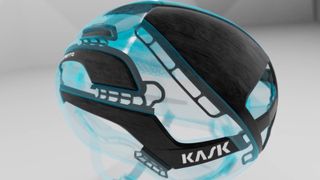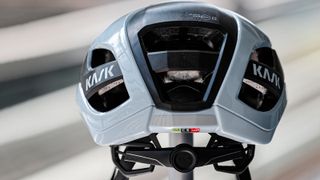Kask launches Elemento helmet, with carbon fibre plates and 3D printed pads
Faster, better ventilated, and safer than Protone, but significantly more expensive too

Kask has today unveiled a brand new road bike helmet that it says will "revolutionise the world of cycling" as we know it. It's called the Elemento, it uses carbon fibre plates to replace EPS foam, and the same 3D printed technology found atop the saddles of Fizik and Specialized for its pads. It is a new addition to the Kask lineup, and boasts a five-star Virginia Tech rating.
With the introduction of multiple new approaches, the Elemento certainly appears to be a technological step forward, and unsurprisingly the price is reflective of that. At £335 / €375 / $400, it's the most expensive road helmet we've seen to date, and when questioned on the matter, Kask is quick to point out that it is aimed at "elite athletes competing in the world's best road, cross-country, cyclocross, and gravel events, as well as cyclists who are driven by the quest for ultimate performance."
Its development began at the Ineos Grenadiers training camp hotel in Majorca, 2019, with a meeting entitled 'New Protone.' However, Kask says that it quickly became a much larger project that sought to create something that wasn't just an iteration of a former success, but a revolutionary product in its own right. So confident are they in the result, that product manager Luca Viano told Cyclingnews "In the next years, everything you see will gather something from the Elemento."
Despite its launch today, the Elemento has actually been in the public eye for some time. It was first spotted on the heads of Ineos Grenadiers 10 months ago at the 2022 Tour de France, but has been held up by the same supply chain issues that have plagued much of the bike industry of late.

New technologies
Two main innovations underpin the new helmet's design. The first of which is a technology Kask calls Fluid Carbon 12, described as a "composite technopolymer capable of absorbing more energy from an impact than traditional materials, and then able to distribute that force more evenly across the helmet."
Specifically, it is a series of carbon composite plates that are used in place of much of the helmet's EPS (expanded polystyrene) foam. Together, they create a shell not dissimilar to tectonic plates. They are held together by joints that enable them to move, in turn absorbing and sharing forces from impacts.

The thickness of these plates is just 1mm. Given the thickness of EPS foam usually sits between 25 and 30mm, this has opened up the inside of the helmet and created larger internal air channels, allowing it to move air – and thus heat – more quickly. This has allowed Kask to maintain better ventilation with smaller holes at the front, which in turn means better aerodynamic performance too. Kask says the primary motivation for using this technology was not necessarily the performance, but safety, and that the performance gains were a happy coincidence.
Get The Leadout Newsletter
The latest race content, interviews, features, reviews and expert buying guides, direct to your inbox!

The Italian brand has doubled down on safety with the introduction of its second new technology, too. Called Multipod, it is better known to you and me as the 3D-printed padding used on Specialized and Fizik saddles. Kask has used the same California-based company, Carbon, whose Digital Light Synthesis Additive Manufacturing technology has been tuned with a rigid outer face and a low-density middle that ensures a shearing motion when impacted, helping to reduce the forces of rotational impacts.
Safety claims
Overall, Kask says its primary main motivation for the Elemento was safety, and by its own standards, it has improved, and it has passed its in-house WG11 testing procedure, which it says is more thorough than the industry standards.
Kask, which claims it has been working closely with independent helmet testing facility Virginia Tech on its testing methods, has previously only ever submitted one of its helmets for testing. That was the Valegro, which received a three-out-of-five-star score of 19.57. The Element has also been put through the test, giving a five-star score of 11.90. For context, the best score received to date is the Giro Aries Spherical with 8.40.
In addition, in order to pass the test for EN-1078 European helmet standards, sensors within the headform cannot exceed 250 G of accelerative force upon impact. For the American CPSC test, it is 300 G. Kask says the Protone Icon, Utopia Y and Valegro are in the range of 90 to 110 G, whereas the Elemento is closer to 80 G of force. Of course, this is only a linear impact, so not directly relevant to the type of impact you'd experience in a crash, but smaller numbers are never bad in this regard.

Performance claims
In terms of where the helmets sits in Kask's range, it is best described as 'premium Protone'. Aerodynamically, Kask quotes a fairly significant advantage in the wind tunnel of a 1.5% reduction in CDA for a "full body in riding position." This is in comparison to Protone Icon (which launched last year as a replacement for the original), as well as unnamed competitors. According to Kask's contracted aerodynamic expert, Luca Oggiano, who also happens to be the Principal Aerodynamicist at Ineos Grenadiers, that equates to around 5-10 watts at 45km/h. At the same time, Kask says it is 0.26 degrees Celsius cooler.
Despite the all-round improvement over the Protone Icon, Kask is keen to reiterate that the Elemento is not here to replace it. The Protone Icon will remain in line, but is now pitched as the 'affordable' performance all-rounder; somewhat distressingly given its £245.00 / $299.00 price tag.
However, Kask did also admit that the Elemento isn't in in a league of its own, stating that the Valegro is still better ventilated and the Utopia Y is still more aerodynamic. So if you find yourself in the market for a new helmet, the Elemento isn't necessarily a no-brainer decision. If the racing performance (putting the increased safety aside for a second) is important consideration, you can get better performance elsewhere in Kask's range, at quite a price saving too.

Price and availability
The Elemento will come in a variety of colours, including black, white, beetle green, oxford blue, red, and silver. A size medium helmet will weigh 260 grams, and it will be priced at €375.00, £335.00, $400.00, and AU$650.00.

Josh is Associate Editor of Cyclingnews – leading our content on the best bikes, kit and the latest breaking tech stories from the pro peloton. He has been with us since the summer of 2019 and throughout that time he's covered everything from buyer's guides and deals to the latest tech news and reviews.
On the bike, Josh has been riding and racing for over 15 years. He started out racing cross country in his teens back when 26-inch wheels and triple chainsets were still mainstream, but he found favour in road racing in his early 20s, racing at a local and national level for Somerset-based Team Tor 2000. These days he rides indoors for convenience and fitness, and outdoors for fun on road, gravel, 'cross and cross-country bikes, the latter usually with his two dogs in tow.
Most Popular



